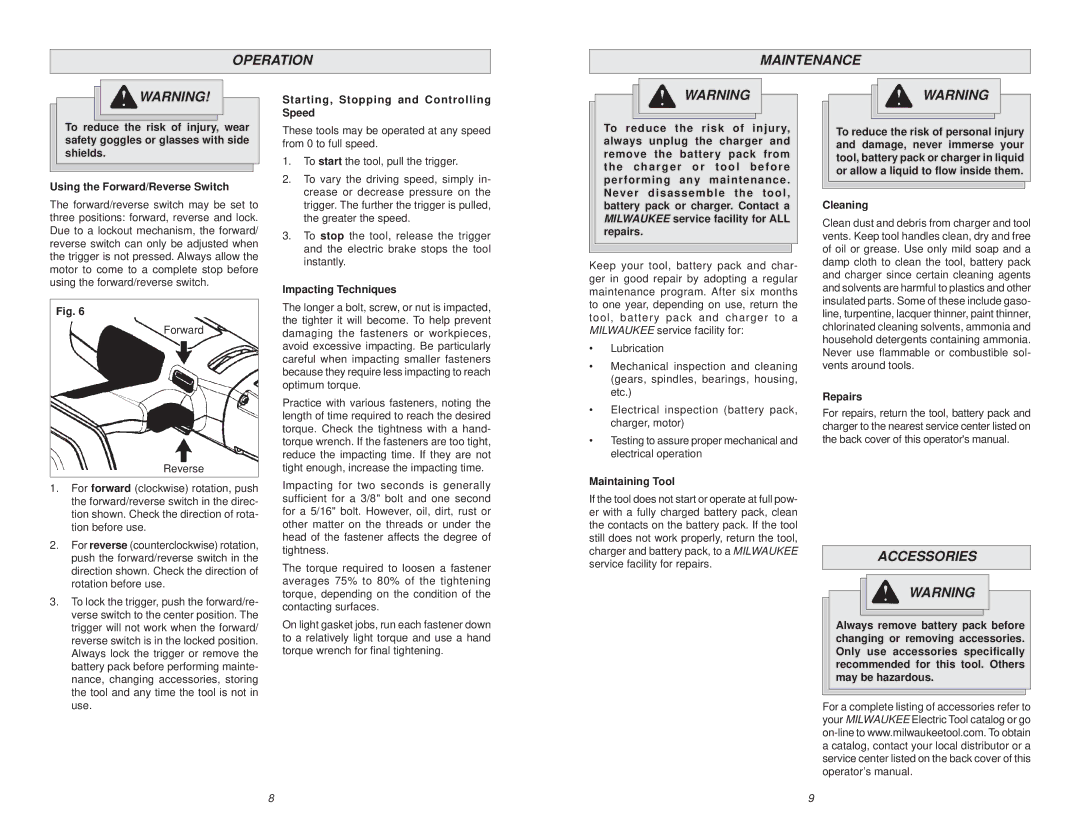
OPERATION
MAINTENANCE
![]() WARNING!
WARNING!
To reduce the risk of injury, wear safety goggles or glasses with side shields.
Starting, Stopping and Controlling Speed
These tools may be operated at any speed from 0 to full speed.
1.To start the tool, pull the trigger.
Using the Forward/Reverse Switch
The forward/reverse switch may be set to three positions: forward, reverse and lock. Due to a lockout mechanism, the forward/ reverse switch can only be adjusted when the trigger is not pressed. Always allow the motor to come to a complete stop before using the forward/reverse switch.
Fig. 6
Forward
2.To vary the driving speed, simply in- crease or decrease pressure on the trigger. The further the trigger is pulled, the greater the speed.
3.To stop the tool, release the trigger and the electric brake stops the tool instantly.
Impacting Techniques
The longer a bolt, screw, or nut is impacted, the tighter it will become. To help prevent damaging the fasteners or workpieces, avoid excessive impacting. Be particularly careful when impacting smaller fasteners because they require less impacting to reach optimum torque.
Practice with various fasteners, noting the
Reverse
1.For forward (clockwise) rotation, push the forward/reverse switch in the direc- tion shown. Check the direction of rota- tion before use.
2.For reverse (counterclockwise) rotation, push the forward/reverse switch in the direction shown. Check the direction of rotation before use.
3.To lock the trigger, push the forward/re- verse switch to the center position. The trigger will not work when the forward/ reverse switch is in the locked position. Always lock the trigger or remove the battery pack before performing mainte- nance, changing accessories, storing the tool and any time the tool is not in use.
length of time required to reach the desired torque. Check the tightness with a hand- torque wrench. If the fasteners are too tight, reduce the impacting time. If they are not tight enough, increase the impacting time.
Impacting for two seconds is generally sufficient for a 3/8" bolt and one second for a 5/16" bolt. However, oil, dirt, rust or other matter on the threads or under the head of the fastener affects the degree of tightness.
The torque required to loosen a fastener averages 75% to 80% of the tightening torque, depending on the condition of the contacting surfaces.
On light gasket jobs, run each fastener down to a relatively light torque and use a hand torque wrench for final tightening.
![]() WARNINGWARNING
WARNINGWARNING
To reduce the risk of injury, always unplug the charger and remove the battery pack from the charger or tool before performing any maintenance. Never disassemble the tool, battery pack or charger. Contact a MILWAUKEE service facility for ALL repairs.
To reduce the risk of personal injury and damage, never immerse your tool, battery pack or charger in liquid or allow a liquid to flow inside them.
Cleaning
Keep your tool, battery pack and char- ger in good repair by adopting a regular maintenance program. After six months to one year, depending on use, return the tool, battery pack and charger to a MILWAUKEE service facility for:
•Lubrication
•Mechanical inspection and cleaning (gears, spindles, bearings, housing, etc.)
Clean dust and debris from charger and tool vents. Keep tool handles clean, dry and free of oil or grease. Use only mild soap and a damp cloth to clean the tool, battery pack and charger since certain cleaning agents and solvents are harmful to plastics and other insulated parts. Some of these include gaso- line, turpentine, lacquer thinner, paint thinner, chlorinated cleaning solvents, ammonia and household detergents containing ammonia. Never use flammable or combustible sol- vents around tools.
Repairs
•Electrical inspection (battery pack, charger, motor)
•Testing to assure proper mechanical and electrical operation
Maintaining Tool
If the tool does not start or operate at full pow- er with a fully charged battery pack, clean the contacts on the battery pack. If the tool still does not work properly, return the tool, charger and battery pack, to a MILWAUKEE service facility for repairs.
For repairs, return the tool, battery pack and charger to the nearest service center listed on the back cover of this operator's manual.
ACCESSORIES
WARNING
Always remove battery pack before changing or removing accessories. Only use accessories specifically recommended for this tool. Others may be hazardous.
For a complete listing of accessories refer to your MILWAUKEE Electric Tool catalog or go
8
9
